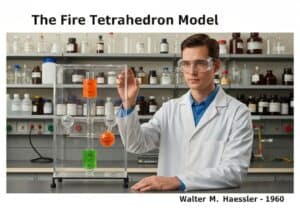This fire class, known as Class K in the US and Class F in Europe and Australia, involves combustible cooking media like vegetable oils, animal fats, and grease. These fires burn at very high temperatures, and applying water is extremely dangerous as it can cause a steam explosion (boilover) that spreads the burning grease. Specialized wet chemical extinguishers are the primary extinguishing method.
Class K / Class F Fires: Cooking Media
The creation of a separate class for cooking media fires was driven by changes in the food service industry. Modern, highly efficient deep-fat fryers heat cooking oils to sustained temperatures at or above their autoignition point. It was discovered that traditional dry chemical (Class B) extinguishers could extinguish the flame, but the oil would often re-ignite because it remained above its autoignition temperature. A new approach was needed.
The solution was the wet chemical agent, typically an aqueous solution of potassium acetate, potassium carbonate, or potassium citrate. When applied to burning cooking oil, this agent performs two functions. First, the water content has a cooling effect, lowering the temperature of the oil below its autoignition point. Second, the potassium salts react with the hot grease in a process called saponification. This chemical reaction creates a thick, soapy foam layer on the surface of the oil. This foam blanket effectively smothers the fire by cutting off the oxygen supply and prevents flammable vapors from escaping, thus preventing re-ignition.
The danger of using water on a grease fire is a key aspect of this class. Because oil is hotter than water’s boiling point, any water introduced instantly flashes to steam, expanding in volume by a factor of about 1,700. This rapid expansion ejects the burning oil from the pan, creating a large fireball and spreading the fire dramatically.
Tipo
Interruzione
Utilizzo
Precursori
- the proliferation of high-efficiency deep-fat fryers in commercial kitchens
- an observed high rate of re-ignition in cooking fires when using traditional class b extinguishers
- a scientific understanding of the saponification chemical reaction
- high incidence of severe fires and injuries in the restaurant industry
Applicazioni
- automatic fire suppression systems installed in commercial kitchen ventilation hoods
- design of wet chemical portable fire extinguishers for restaurants and food processing plants
- fire safety education for culinary students and home cooks
- building code requirements for commercial cooking operations
- development of cooking oils with higher smoke points and reduced flammability
Brevetti:
Potenziali idee innovative
Livelli! Iscrizione richiesta
Per accedere a questo contenuto devi essere un membro di !Professionals (100% free)!
DISPONIBILE PER NUOVE SFIDE
Ingegnere meccanico, responsabile di progetto, ingegneria di processo o ricerca e sviluppo
Disponibile per una nuova sfida con breve preavviso.
Contattami su LinkedIn
Integrazione di componenti elettronici in plastica e metallo, progettazione in base ai costi, GMP, ergonomia, dispositivi e materiali di consumo di medio-alto volume, produzione snella, settori regolamentati, CE e FDA, CAD, Solidworks, Lean Sigma Black Belt, ISO 13485 in ambito medico
Stiamo cercando un nuovo sponsor
La tua azienda o istituzione si occupa di tecnica, scienza o ricerca?
> inviaci un messaggio <
Ricevi tutti i nuovi articoli
Gratuito, no spam, email non distribuita né rivenduta
oppure puoi ottenere la tua iscrizione completa -gratuitamente- per accedere a tutti i contenuti riservati >Qui<
Principi di invenzione, innovazione e tecnica correlati












